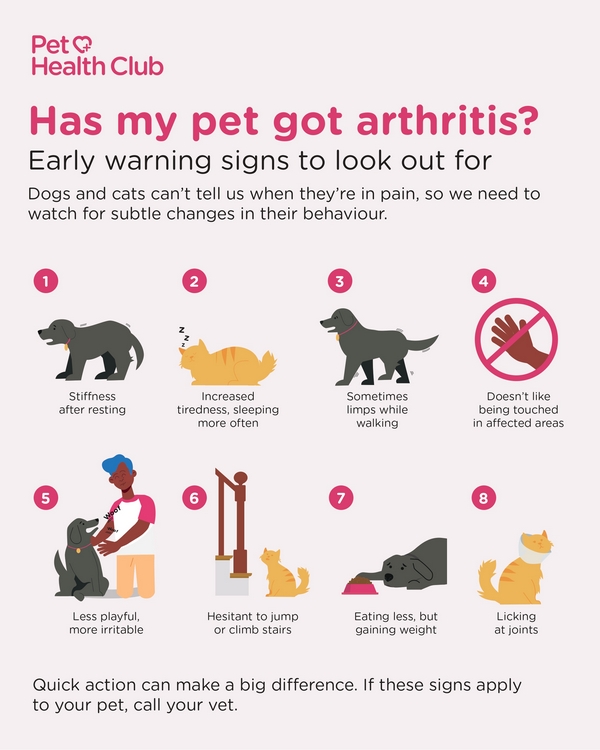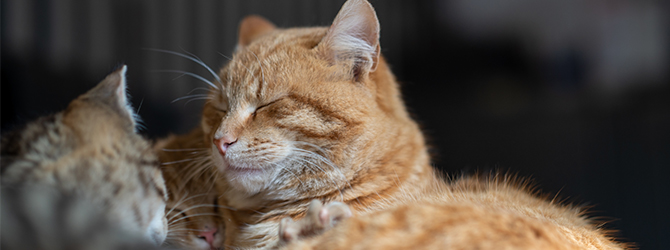Arthritis in cats: signs, causes & treatments
Arthritis in cats (the suffix ‘itis’ means inflammation, and arthritis simply means inflammation of the joints) is a common problem that gradually gets worse and is usually permanent.
It's estimated that between 60 to 90% of older cats suffer from the most common form, osteoarthritis – also known as degenerative joint disease (DJD). It involves the gradual degeneration of joint cartilage, leading to diminished joint function and pain. It can make even simple movements painful.
Key takeaways
- Up to 90% of older cats develop osteoarthritis, characterised by deteriorating joint cartilage, leading to pain and limited mobility
- Signs include stiffness, difficulty jumping, swollen joints, and changes in behaviour such as increased lethargy
- Arthritis in cats is often age-related but can also be triggered by weight gain, injuries, or genetic conditions such as hip dysplasia
- Management strategies include maintaining a healthy weight, regular gentle exercise, prescribed NSAIDs, and dietary supplements
Signs of arthritis in cats
Stiffness and discomfort are likely to be the first hints that your cat may be developing osteoarthritis, and these symptoms are often made worse by cold or damp conditions. The signs of cat arthritis tend to appear gradually and become increasingly worse. If your cat displays any of the symptoms below, make an appointment with your vet to get her checked out.
- Stiffness especially after rest or exercise
- Weight gain
- Increased sleeping and lethargy
- Reluctance to jump up to – or down from – high surfaces
- Painful, swollen joints
- Intermittent lameness
- Reluctance to move
- Irritability and depression
- Loss of appetite
It is important to realise cats do not show pain in the same way as humans – they don’t cry or yelp, and sometimes the only sign is that they are sleeping more, or reluctant to jump to areas they used to love exploring. There are many ways in which your vet can manage arthritis that can relieve your cat’s pain.

What causes cat arthritis?
The bones inside your cat’s joints are covered by a layer of cartilage. As your cat ages, this cartilage may become worn, and the bones it previously protected rub together, no longer gliding smoothly. As well as causing pain and discomfort, this rubbing can cause the joints to become inflamed.
Osteoarthritis typically occurs with age but is worsened by weight gain. It may affect fit and healthy cats from an early age, due to problems with the development of the bones and joints, but this is more unusual. Cats that have experienced an injury or trauma due to an accident may also be more likely to develop arthritis. Hip dysplasia can also lead to arthritis in cats.
Read more: Feline dementia
Treatment for arthritis in cats
While there's no cure for osteoarthritis, there are many treatment options that may help to ease your cat’s discomfort – from anti-inflammatory therapy to non-steroidal anti-inflammatory drugs (NSAIDs) – and your vet will talk you through the choices available.
Here's a handy breakdown of the treatments that can help manage your cat's symptoms and improve their quality of life:
| Treatment | Description |
|---|---|
| Weight management | Keeping your cat at a healthy weight reduces stress on her joints. |
| Controlled exercise | Regular, gentle exercise helps maintain joint mobility and muscle strength. |
| Pain relief | Non-steroidal anti-inflammatory drugs (NSAIDs) prescribed by your vet can reduce pain and inflammation. Never give human medications as they can be toxic to cats. |
| Nutritional supplements | Vet-approved supplements may help to improve joint function. |
| Warm compresses | Applying warmth to sore joints can decrease stiffness and pain. |
| Environmental modifications | Providing steps or ramps can help your cat reach her favourite spots without having to jump. |
If your cat requires long-term medication for arthritis, joining Pet Health Club could be a sensible move. Members get a 20% discount on lifetime medications, plus many other benefits such as vaccinations, flea and worm treatments, and six-monthly health checks.
Other types of arthritis in cats
Aside from osteoarthritis, cats can suffer from other forms of arthritis. Here’s a quick breakdown:
Septic arthritis
What it is: Occurs when an infection, usually from bacteria, gets into a joint. This can happen through injuries, during surgery, or less commonly, through an infection spreading in the body.
Common signs: The affected joint becomes swollen, painful, and warm to the touch. The cat might have a fever, be less active, and not want to eat.
How it’s treated: Treatment usually involves antibiotics and sometimes surgery to clean the joint.
Immune-mediated arthritis
What it is: Happens when the cat’s immune system attacks its own joints. This can lead to arthritis in multiple joints and is similar to conditions like rheumatoid arthritis in humans.
Common signs: Symptoms include joint swelling, pain, and occasional fever. These symptoms can come and go unpredictably.
How it’s treated: It’s typically managed with medications that reduce immune system activity and inflammation.
Cancerous arthritis
What it is: This rare form is caused by a tumor in the joint, known as synovial cell sarcoma.
Common signs: The cat may show ongoing lameness, joint swelling, and pain that normal painkillers do not relieve.
How it’s treated: Treatment often requires surgery, which may include removing the affected limb, and possibly chemotherapy if the cancer has spread.
How to prevent arthritis in cats
- Make sure your cat's weight is right to ease joint stress
- Feed your cat a diet that suits their age and health needs
- Make sure your cat is active and engaged as this helps keep their joints healthy
- Start vet-approved supplements early, particularly for cats at risk
Read more: Hip dysplasia in cats
Need help and advice on arthritis in cats?
For expert advice on arthritis in cats, contact your local vet.
Find your nearest vet using our find a vet page, or speak to a vet online using online vets.



